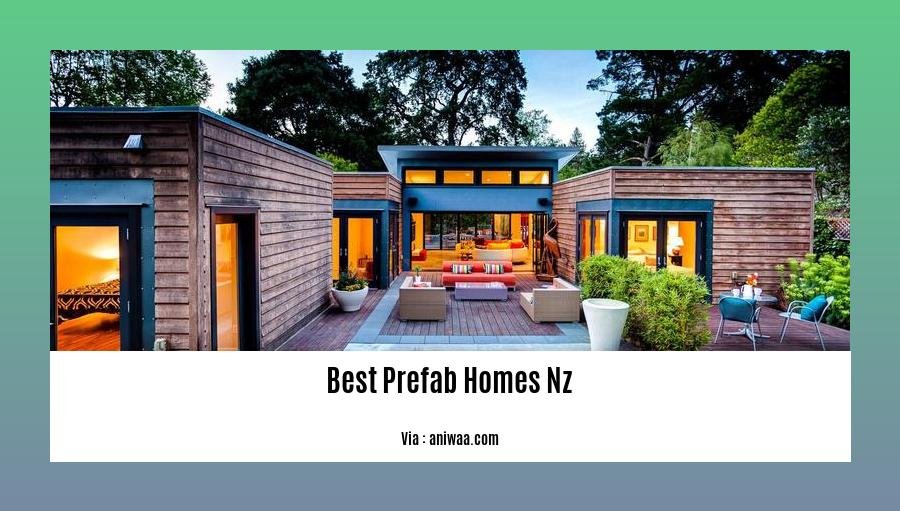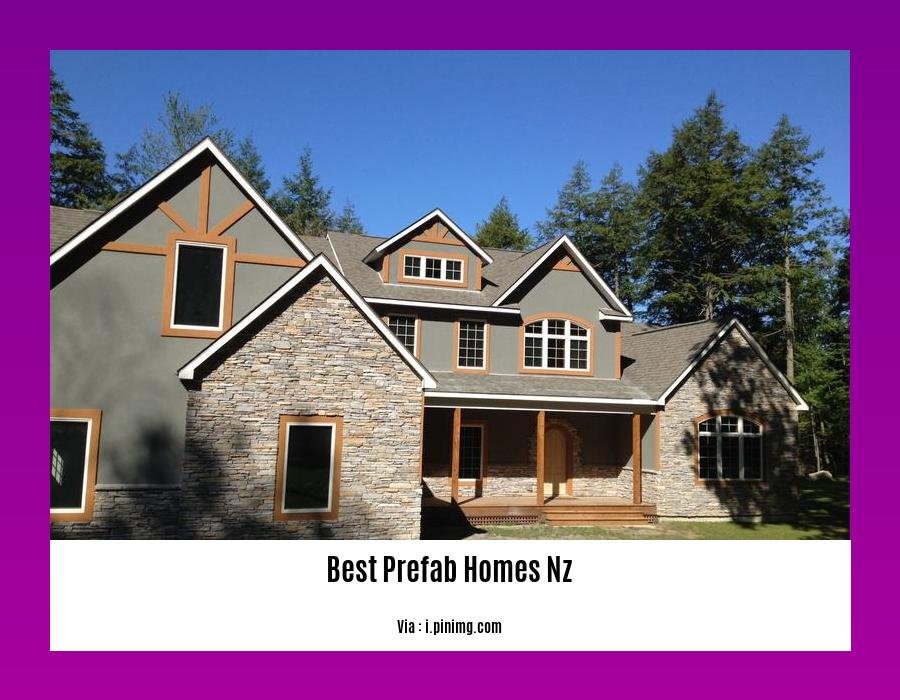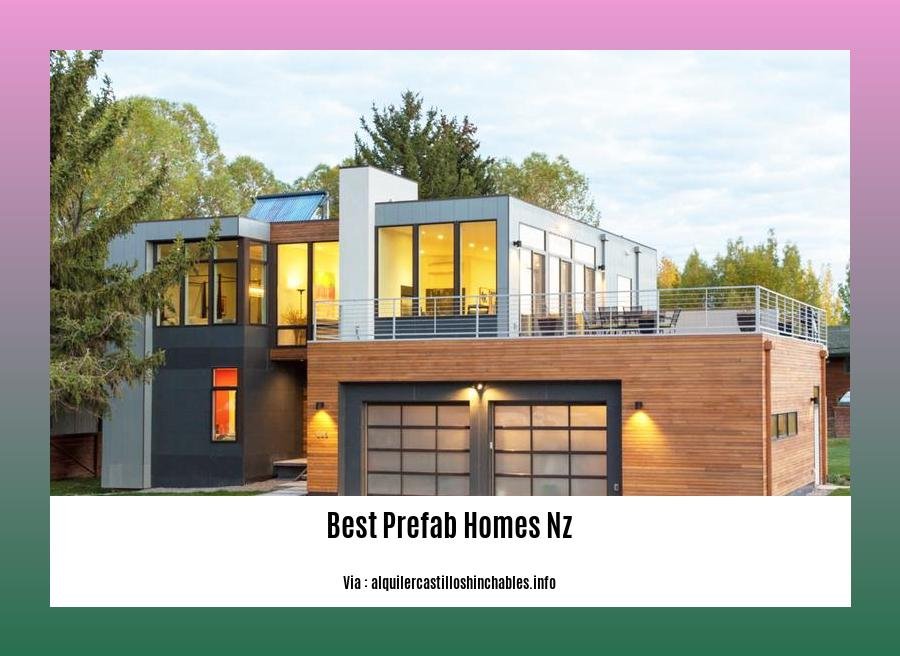Unveiling the Best Prefab Homes in New Zealand: A Guide to Navigating the World of Prefabricated Housing Solutions [- A Guide to the Best Prefab Homes in New Zealand]. Discover the allure of modern living with prefab homes that redefine comfort, sustainability, and affordability. From compact dwellings to sprawling family havens, explore the diverse range of prefab homes, tailored to suit every lifestyle and budget.
Key Takeaways:
- Prefab homes offer a cost-effective, efficient, and eco-friendly alternative to traditional building methods in New Zealand.
- Prefab homes can be easily customized to suit individual needs and preferences, making them adaptable to different locations and lifestyles.
- Top prefab companies in New Zealand include Nook Homes, Manor Build, Advance Build, Nest Homes, and Árbol Eco Homes.
- When selecting a prefab home, factors to consider include cost, construction time, benefits offered, and customization options available.
- Researching and comparing different prefab companies is crucial to finding one that aligns with individual needs and preferences.
Best Prefab Homes NZ

Prefabricated homes are gaining traction in New Zealand for their cost-effectiveness, construction efficiency, and environmental sustainability. With the growing demand, numerous prefab companies have emerged, offering diverse options to cater to different needs and preferences. In this article, we’ll delve into the world of prefab homes in New Zealand, exploring the top companies and the crucial factors to consider when making a purchase.
Top Prefab Companies in New Zealand
-
Nook Homes: Renowned for their luxury modular prefabs, Nook Homes takes care of every aspect from the initial brief to final delivery. Their turnkey approach ensures a hassle-free experience for homeowners.
-
Manor Build: Based in the North Island, Manor Build specializes in practical and affordable prefab homes. They offer various customizable options, allowing buyers to tailor their homes to their unique requirements.
-
Advance Build: Operating in the upper North Island, Advance Build places emphasis on quality construction and energy efficiency. Their prefab homes are meticulously crafted to withstand New Zealand’s diverse climate.
-
Nest Homes: Eco-consciousness is at the heart of Nest Homes’ prefab offerings. They employ sustainable materials and construction methods to minimize environmental impact, making their homes a haven for the eco-minded.
-
Árbol Eco Homes: Another champion of eco-friendly prefab homes, Árbol Eco Homes utilizes sustainable materials and construction practices to create environmentally responsible living spaces.
Factors to Consider When Choosing a Prefab Home
-
Cost: Prefab homes offer competitive pricing compared to traditional construction methods. Determine your budget and explore the options available within your financial constraints.
-
Construction Time: Prefab homes are known for their rapid construction, often completed within weeks or a few months. Consider the time frame that best suits your needs and lifestyle.
-
Benefits: Prefab homes provide several advantages, including energy efficiency, durability, and reduced maintenance. Carefully evaluate the benefits to ensure they align with your expectations.
-
Customization Options: Many prefab companies offer customization options, allowing you to personalize your home’s design, layout, and features. Ascertain the level of customization available to meet your specific requirements.
-
Company Reputation: Research the reputation of different prefab companies. Read reviews, seek recommendations, and visit display homes to gain insights into the quality of their work and customer service.
Conclusion
In the realm of prefab homes in New Zealand, there’s a wealth of options to explore. With a wide range of companies and customizable features, you’re sure to find a prefab home that perfectly aligns with your needs, preferences, and budget. Embark on this journey, consider the factors discussed in this article, and make an informed decision that leads you to your dream prefab home in New Zealand.
- Planning to buy a manufactured home in California? You won’t want to miss this guide to the best manufactured homes in California.
- For those seeking the best in prefab homes in Canada, look no further than this comprehensive guide to the best prefab homes Canada has to offer.
- In need of some shopping inspiration? Discover the best shopping in Naples Florida and get ready to indulge in a unique shopping experience.
- Ready to take the plunge into building a tiny house? This guide to building a tiny house in Ontario will provide you with all the essential information you need to get started.
Prefab Homes: Tailored to Your Unique Vision

Hey there, home enthusiasts! In the realm of prefab homes, customization reigns supreme. These homes aren’t just cookie-cutter structures; they’re blank canvases awaiting your personal touch. Let’s dive into how prefab homes can be tailored to meet your specific needs and wants:
Customization Options:
- Design: Architects and builders collaborate to create a design that reflects your style, whether it’s modern, traditional, or something in between.
- Layout: Room configurations, number of bedrooms and bathrooms, and the flow of the home can be adjusted to suit your lifestyle.
- Materials: Choose from a range of materials for your home’s exterior and interior, including eco-friendly options.
- Features: Add personal touches like a gourmet kitchen, luxurious bathroom, or outdoor living space that complements your lifestyle.
Benefits of Customization:
- Uniqueness: Your prefab home will be a one-of-a-kind reflection of your personality and preferences.
- Functionality: A customized home caters to your specific needs, ensuring optimal comfort and convenience.
- Investment: Investing in a customized prefab home can increase its value over time.
Making Customization a Reality:
- Research: Explore prefab companies that offer customization options and read reviews to find reputable builders.
- Collaboration: Work closely with architects and builders to communicate your vision and ensure they understand your requirements.
- Flexibility: Be open to suggestions and ideas from professionals, as they may offer innovative solutions to achieve your desired outcome.
- Budget: Set a realistic budget for customization and discuss cost implications with your builder.
Remember, customization is a journey, not a destination. It’s an opportunity to create a home that truly reflects who you are and how you live. Embrace the process and enjoy the experience of building your dream home.
Key Takeaways:
- Customization: Prefab homes offer a high degree of customization, allowing you to tailor the design, layout, materials, and features to suit your specific needs and wants.
- Benefits: Customization creates a unique and functional home that reflects your personality and lifestyle, potentially increasing its value over time.
- Collaboration: Work closely with architects and builders to bring your vision to life, considering their expertise and suggestions for innovative solutions.
- Budget: Set a realistic budget for customization and discuss cost implications with your builder to ensure affordability.
Relevant Sources:
Prefab Homes: A Modern and Sustainable Housing Solution
Prefab Homes: The Future of Housing in Indonesia?
The cost of a prefab home will vary depending on the size, type, and features of the home.
When it comes to prefab homes in New Zealand, the cost can vary significantly based on several factors. The size of the home, the type of prefab construction, and the features you choose all play a role in determining the final price tag.
The cost of a prefab home will vary depending on the size, type, and features of the home. Some prefab homes are small and basic, while others are large and luxurious. The type of construction also affects the cost, with modular homes being more expensive than panelized homes. Finally, the features you choose for your prefab home, such as the number of bedrooms and bathrooms, will also affect the price.
Here’s a breakdown of how size, type, and features impact the cost of a prefab home in New Zealand:
Size:
- Smaller prefab homes are typically less expensive than larger ones.
- The cost per square foot for a prefab home can range from $100 to $200.
- A 1,000-square-foot prefab home could cost between $100,000 and $200,000.
Type:
- Modular homes are built in sections in a factory and then assembled on-site. They are typically more expensive than panelized homes because they require more labor to build.
- Panelized homes are built using pre-fabricated panels that are assembled on-site. They are typically less expensive than modular homes because they require less labor to build.
Features:
- The number of bedrooms and bathrooms in a prefab home will affect the cost.
- Upgraded features, such as granite countertops or stainless steel appliances, will also increase the cost.
Additional Costs:
- In addition to the cost of the prefab home itself, you will also need to factor in the cost of land, foundation, permits, and utilities.
- The cost of land can vary significantly depending on the location.
- The cost of a foundation can range from $10,000 to $50,000.
- The cost of permits and utilities can vary depending on the local government regulations.
Key Takeaways:
- Prefab homes in New Zealand vary in cost depending on size, type, and features.
- Modular homes are typically more expensive than panelized homes.
- The cost per square foot for a prefab home can range from $100 to $200.
- Additional costs to consider include land, foundation, permits, and utilities.
Citations:
Prefab Homes: A Comprehensive Guide
Complete Guide To The Cost Of A Prefab Home (2023 Prices)
Prefab homes can be built quickly and easily, making them a great option for people who are in a hurry to move into a new home.
Are you in a rush to move into a new home? Want a house that’s as speedy to assemble as a puzzle? Well, prefab homes are your answer! These homes, often called modular or prefabricated, are the new kids in town, and they’re taking the construction world by storm.
Key Takeaways:
- Prefab homes are speedily constructed, saving you precious time and allowing you to settle into your dream home faster.
- These homes can be assembled anywhere, making them perfect for remote or challenging locations.
- Prefab homes offer a range of designs to suit every taste, from cozy cabins to modern masterpieces.
- You can save money when choosing a prefab home rather than a traditional stick-built home.
Speedy Construction:
Prefab homes are the Usain Bolt of the construction world. They can be assembled in a snap, thanks to their prefabricated components. Some models can be ready in just a few days, while others might take a bit longer. But compared to traditional homes that crawl along at a snail’s pace, prefab homes are like a rocket ship!
Global Accessibility:
Want to live off the grid, surrounded by breathtaking nature? Or maybe you’re drawn to the hustle and bustle of the city? Prefab homes don’t discriminate; they can be built anywhere! Even the most remote or challenging locations are no match for these adaptable homes.
Diverse Designs:
Prefab homes aren’t just cookie-cutter boxes. They come in all shapes, sizes, and styles, so you can find a home that perfectly matches your taste and lifestyle. From cozy cabins nestled in the mountains to sleek, modern homes that would make an architect swoon, there’s a prefab home out there for everyone.
Affordability:
Prefabricated homes often cost less than traditional homes. This is because they’re made in factories, where the process is more efficient, and there are fewer labor costs. So, if you’re looking for a beautiful home without breaking the bank, a prefab home might be the way to go.
Considerations:
Before you jump on the prefab bandwagon, consider a few things. First, some prefab homes may have limited customization options compared to traditional homes. Also, transportation costs can be higher if you’re building in a remote area. But overall, prefab homes offer a fantastic combination of speed, affordability, and quality.
If you’re in a rush to move into your new home, a prefab home may be the perfect option for you. These homes are built quickly, easily, and can be customized to your liking. Plus, they’re often more affordable than traditional homes.
Sources:
Prefab Homes: A Modern and Sustainable Housing Solution
The 7 Best & Most Sustainable Prefab Homes
FAQ
Q1: What are the top prefab home companies in New Zealand?
A1: Some of the leading prefab home companies in New Zealand include Nook Homes, Manor Build, Advance Build, Nest Homes, and Árbol Eco Homes. These companies offer a range of customizable prefab homes that cater to different needs and preferences.
Q2: What are the benefits of choosing a prefab home in New Zealand?
A2: Prefab homes in New Zealand offer several advantages, including affordability, sustainability, rapid construction time, mobility, customization options, and quality control. They are also energy-efficient and often come with pre-designed insulation and ventilation systems.
Q3: What factors should I consider when choosing a prefab home company in New Zealand?
A3: When selecting a prefab home company in New Zealand, it’s important to consider factors like cost, construction time, customization options, energy efficiency, and the company’s reputation. It’s also essential to research local regulations and building codes to ensure compliance.
Q4: How much do prefab homes typically cost in New Zealand?
A4: The cost of prefab homes in New Zealand can vary depending on the size, design, and features. Generally, prefab homes are more affordable than traditional stick-built homes, with an average cost ranging from $90 to $120 per square foot.
Q5: What are some of the challenges associated with prefab homes in New Zealand?
A5: Some potential challenges with prefab homes in New Zealand include design limitations due to pre-existing modular components, transportation logistics for moving prefabricated components to remote or difficult-to-access locations, and the need for proper site preparation and compliance with local regulations and building codes.
- Seal for butcher block: Find the best food-safe finish - December 29, 2025
- Finishes For Butcher Block Counters: Choosing The Right Food-Safe Option - December 28, 2025
- Kitchen Countertop Ideas: Find the Perfect Surface for You - December 27, 2025










